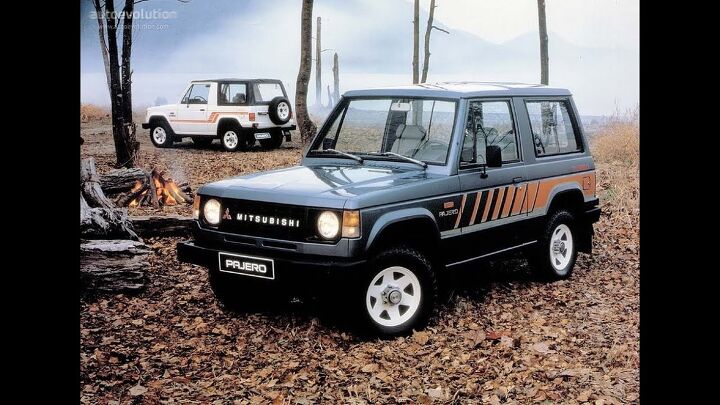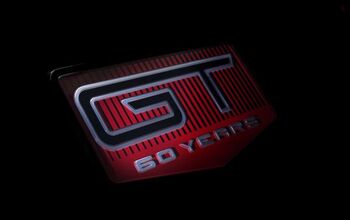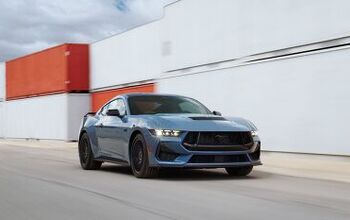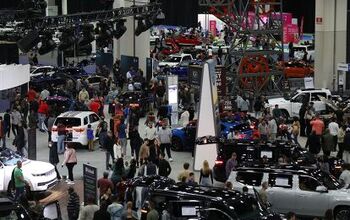Abandoned History: Dodge's Dead Import Trucks (Part III)

In a captive import enterprise that began in 1979, Dodge sold Mitsubishi’s compact pickup (aka Mighty Max in North America) to compete with the likes of the Ford (Mazda) Courier and the Chevrolet (Isuzu) LUV. Badged as the Ram 50, the truck was sold through two generations, 1979-1986 and 1987-1994. By the Nineties, the second-gen was showing its age, and Dodge decided it would rather focus on its own midsize truck, the Dakota.
But there was another captive import that arrived at the very same time as the second edition of the Ram 50. Say hello to the Raider.
In the early-mid Eighties, the compact truck-based SUV was just getting its start. Think of the Chevrolet S-10 Blazer (1983), the Bronco II (1984), the XJ Cherokee (1984), and the Toyota 4Runner (1984). Take a truck, add a rear seat and enclose the cargo area, and maybe another set of doors. Boom! You now have an SUV with much greater profit margins than a plain old pickup, courtesy of an American customer base eager to be perceived as exciting and cool.
When the class was getting started circa ’83, Chrysler had exactly one SUV on offer: The full-size, two-door Ramcharger. Originally launched in 1974, Ramcharger was updated to a second generation for 1982. The lineup was consolidated that year, as customers proved (again) they were not interested in a Plymouth branded truck: Plymouth offered the Trail Duster version of the Ramcharger from 1974 to 1981. The TD’s latter few years were shared with the lot poison that was the Arrow, Plymouth’s version of the Dodge D-50.
Keep in mind, the new Ramcharger was more of a refresh than an all-new model. Like every other full-size pickup at Dodge, the new Ramcharger used the same platform as the old one: Chrysler’s AD that debuted in 1972 on the D Series. Obviously, that wouldn’t work for a compact offering. The Dakota should have turned into a Durango circa 1987, but Chrysler decided not to go there. The compact SUV answer lie in Mitsubishi.
And not just any old Mitsubishi, but the legendary Pajero (RIP 2021), which you’d know as Montero. The Montero was a new offering at Mitsubishi in 1982, after it made a fall debut at the 1981 Tokyo Motor Show. The SUV garnered an almost immediate off-roading pedigree when it finished third place in the grueling Paris-Dakar rally in 1984. Worth noting, the truck used in the race was a lightly modified version of the production-spec Pajero.
The Montero was the first homegrown SUV from Mitsubishi and replaced the license-built Mitsubishi Jeep Delivery Wagon. That was the final nomenclature for the Jeep CJ and marked the conclusion of a deal that dated back to 1953. At that time, Jeep was introduced to Japan for the first time when Willys allowed Mitsubishi to sell its wares there as competition to the likes of the Toyota Land Cruiser and Nissan’s Patrol. Mitsubishi would slim down its Jeep production after the Montero’s debut, though said production continued through 1998.
Montero’s initial shape was the short-wheelbase three-door version, which could be fitted with a canvas or metal roof. Mitsubishi aimed for tech and sophistication in its new SUV, contrary to the agricultural nature of the Jeeps it was so used to building. The truck was launched with a selection of turbodiesel engines and had standard power steering and a double-wishbone suspension at the front.
Unlike much of the competition domestic or otherwise, all Pajeros had four-wheel drive; there was never a 2WD trim. Most early examples paired the engine to a five-speed manual transmission, but a four-speed Aisin automatic was also available.
It was always in the plans for the Montero to grow into a midsize model, which was accomplished via the introduction of the long-wheelbase five-door version in early 1983. With over a foot longer wheelbase than the shorty model, the five-door was a true midsize SUV. The three-door’s wheelbase was 92.5 inches, while the five-door was 106.1 inches. Overall length of the three-door was 157.3 inches, while its big brother was 183.1 inches. The five-door was half an inch wider than the three-door, at 66.6 inches overall. The five-door was taller too, at 74.4 inches compared to 72.8 for the three-door.
Of absolute importance was Mitsubishi’s correct assessment that buyers would desire a third row in a midsize SUV. The five-door version had seven seats when equipped with a fold-down third row. Montero beat many manufacturers to market with this option, and today selling a midsize SUV or crossover without a third row is a bit of a folly.
Stylistically speaking, the first Montero was a couple of boxes on wheels: One box for the engine, and one box for the passenger compartment. The looks were the logical shapes everyone expected from a utility vehicle those days. There were two round headlamps at the front, separated by an egg-crate grille. Bumpers were chromed with black rubber caps. There were not many details on the body other than a power bulge hood, a simple character line that ran horizontally and captured the door handles, and a trim strip across the lower half of the body.
Interiors on the Montero mirrored the practical utility ethos, with their square shapes finished in basic materials. Gauges were simple, comprehensive, and finished with orange lettering on a black background. The passenger side of the dash was dominated by a large grab handle and not much else. Worth noting, materials and trim for seats and dash did change over the years, as the upmarket SUV became an entity and Mitsubishi responded accordingly.
By the end of the first generation’s run, there were wood trim appliques, an optional and enormous sunroof, heated seats, leather upholstery, and many luxury options in the Exceed trim. Niceties for drivability like standard disc brakes and adjustable shocks arrived by the mid-Eighties. There were additional roof options for the five-door too, and in many markets, Pajero had standard, semi-high, and high-roof variants. All depended on how much headroom a customer wanted for their various safari-ing adventures.
Initially, all engines were of the inline-four persuasion. They were naturally aspirated if fueled with gasoline, and naturally aspirated or turbocharged if diesel. Basic power on the gasoline end of things was via the 2.0-liter 4G63 we’ve seen many times before, also used in the Ram 50. The top gasoline engine initially was the 2.6-liter 4G54, also from the Ram 50. Per the demands of the North American market, eventually a V6 was introduced (1988+), the 3.0-liter 6G72 that most people hated in the Ram 50.
As for diesels, there was one naturally aspirated offering: The 2.3-liter 4D55 that was offered for a very short while in the Ford Ranger. Other diesel mills were turbocharged and included the 4D55T and the 2.5-liter 4D56T (1986+). The 2.5 proved a popular engine internationally and was also picked up by Hyundai for its use. Amazingly, the 4D56T is still in production today and is built by Mitsubishi in Kyoto and Hyundai at Ulsan.
Speaking of Hyundai, they loved the first-generation Montero. Mitsubishi was ready with the second generation Montero for 1992, so at the close of 1991 production, they sold the tooling to Hyundai. Hyundai immediately introduced the Galloper. A successful product for the South Korean brand, the Galloper found many buyers in its home market and was even exported to Europe. It continued on offer through 2003, when the 21-year-old platform was allowed to die. Back to Dodge.
In 1987 there was a new Ram 50, a new Dakota, and the new Raider to satisfy Chrysler’s compact SUV need. The transition from Montero to Raider was a simple one from Dodge’s perspective. Dodge selected a new grille design, one of horizontal slats instead of the Montero’s egg-crate look. Finally, there was a badge that said “RAIDER” atop the grille, instead of the block Mitsubishi lettering used on the Montero’s hood.
Dodge sold the Raider only as a three-door model and left the five-door to Mitsubishi dealers. With an identical wheelbase and nearly the same exterior length, the five-door Montero was much too close in size to the Ramcharger to sell alongside it. At 27 inches shorter than the Ramcharger, the Raider wasn’t direct competition.
Dodge advertised the Raider as a well-equipped vehicle, with its standard four-wheel drive, and a “big” 2.6-liter inline-four from the get-go. A year later the 3.0 V6 arrived and was accompanied by a proud V6 badge in the grille. Raiders were often seen with two-tone paint, tape stripe graphics, bull bars, side steps, and chromed wheels. The black and gold color scheme was especially nice.
The competition Dodge called out for the Raider included the XE trim of the Pathfinder, and the Toyota 4Runner. Raider was much cheaper than both of those as new and was covered by Chrysler’s 3-year, 36,000-mile warranty.
It’s difficult to find pricing data broken out by trim or engine on the Raider. What your author can come up with is a base MSRP of $12,830 ($30,459 adj.) in 1989. Assume a decent price jump for the 3.0-liter V6, and modest increases for any dealer-installed equipment like tape stripes or fog lamps.
Even though it was well-equipped for the money, the appeal of a Dodge branded Mitsubishi SUV was weaker than expected. One might proffer that upon the availability of the five-door Montero, many Montero intenders went to their Mitsubishi dealer to purchase that instead. Almost all compact SUVs of the mid-Eighties were quickly turned into five-door versions, as Americans wanted more space and easier access to the back seats. The three-doors fell quickly out of fashion, and by the mid-Nineties they were all but gone.
Chrysler responded appropriately to the slow sales and canceled the Raider after just three years on the market. It was not replaced by anything in the lineup, and Dodge wouldn’t offer another compact SUV until the Nitro of 2007 (what a weird thing that was). Chrysler sort of played catch up with its SUV offerings for quite some time: The company went without a midsize SUV until 1998’s introduction of the Durango and has never fielded a Tahoe/Suburban type competitor until very recently with various Jeeps. The Raider was just a blip on the radar, largely forgotten. But we’ll always remember here at Rare Rides and Abandoned History.
[Images: Dodge, Mitsubishi]

Interested in lots of cars and their various historical contexts. Started writing articles for TTAC in late 2016, when my first posts were QOTDs. From there I started a few new series like Rare Rides, Buy/Drive/Burn, Abandoned History, and most recently Rare Rides Icons. Operating from a home base in Cincinnati, Ohio, a relative auto journalist dead zone. Many of my articles are prompted by something I'll see on social media that sparks my interest and causes me to research. Finding articles and information from the early days of the internet and beyond that covers the little details lost to time: trim packages, color and wheel choices, interior fabrics. Beyond those, I'm fascinated by automotive industry experiments, both failures and successes. Lately I've taken an interest in AI, and generating "what if" type images for car models long dead. Reincarnating a modern Toyota Paseo, Lincoln Mark IX, or Isuzu Trooper through a text prompt is fun. Fun to post them on Twitter too, and watch people overreact. To that end, the social media I use most is Twitter, @CoreyLewis86. I also contribute pieces for Forbes Wheels and Forbes Home.
More by Corey Lewis
Latest Car Reviews
Read moreLatest Product Reviews
Read moreRecent Comments
- Jalop1991 This is easy. The CX-5 is gawdawful uncomfortable.
- Aaron This is literally my junkyard for my 2001 Chevy Tracker, 1998 Volvo S70, and 2002 Toyota Camry. Glad you could visit!
- Lou_BC Let me see. Humans are fallible. They can be very greedy. Politicians sell to the highest bidder. What could go wrong?
- SPPPP Vibrant color 9 times out of 10 for me. There may be a few shapes that look just right in metallic gray, for example. There are a few nices ones out there. And I like VW "White Silver". But I'd usually prefer a deep red or a vibrant metallic green. Or a bright blue.
- 28-Cars-Later Say it ain't so, so reboot #6* isn't going to change anything?[list=1][*]V4-6-8 and High "Tech" 4100.[/*][*]Front wheel drive sooooo modern.[/*][*]NOrthSTARt.[/*][*]Catera wooooo.[/*][*]ATS all the things.[/*][*]We're *are* your daddy's Tesla. [/*][/list=1]







































Comments
Join the conversation
When I was a teenager a leader at a museum I volunteered at had one 4cyl manual red. We used to blast around the woods near the museum in the thing. They are great offroad. Great visibility. Fun little things. A later coworker had a 2nd job at BHPH, and borrowed a blue v6 manual one off the lot one day, that was entertaining because in 4wd low if you popped the clutch just right you could lift thee front wheel off the ground briefly. Fun fact if I remember correctly you can stuff 33-34" tall tires as long as they are fairly narrow and with the right backspacing under a stock height one of these.
One of my neighbors had an 88 Raider with the 4 cyl and 5spd. It had dark blue monotone paint and chrome stock wheels. If I recall right they had that truck for about 20 years and sold about 2 years ago for $3500. The ad didn't last much. The truck was in good shape, at least aesthetically and had no rust. I toyed with the idea of getting it as an off-road toy (a 2dr Tracker was also a contender) but was wary about parts availability (maybe unfounded) and had just got my truck 6 months earlier.